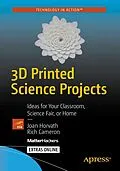Create 3D printable models that can help students from kindergarten through grad school learn math, physics, botany, chemistry, engineering and more.
Each of the eight topics is designed to be customized by you to create a wide range of projects suitable for science fairs, extra credit, or classroom demonstrations. Science fair project suggestions and extensive "where to learn more" resources are included, too. You will add another dimension to your textbook understanding of science.
What You'll Learn
- Create (and present the science behind) 3D printed models.
- Use a 3D printer to create those models as simply as possible.
- Discover new science insights from designing 3D models.
Who This Book Is For
Autorentext
As an engineer and management consultant, Joan Horvath has coordinated first-of-a-kind interdisciplinary technical and business projects, helping people with no common vocabulary (startups, universities, small towns, etc). work together. Her experience as a systems engineer has spanned software development, spacecraft flight operations, risk management, and spacecraft/ground system test and contingency planning.As an educator, Joan's passion is bringing science and technology to the non-specialist in a comprehensible and entertaining way that will stay with the learner for a lifetime.
Rich Cameron is a co-founder of Pasadena-based Nonscriptum LLC. Nonscriptum consults for educational and scientific users in the areas of 3D printing and maker technologies. Rich (known online as Whosawhatsis) is an experienced open source developer who has been a key member of the RepRap 3D-printer development community for many years. His designs include the original spring/lever extruder mechanism used on many 3D printers, the RepRap Wallace, and the Deezmaker Bukito portable 3D printer. By building and modifying several of the early open source 3D printers to wrestle unprecedented performance out of them, he has become an expert at maximizing the print quality of filament-based printers. When he's not busy making every aspect of his own 3D printers better, from slicing software to firmware and hardware, he likes to share that knowledge and experience online so that he can help make everyone else's printers better too.
Inhalt
1. 3D Math Functions
2. Light and Other Waves
3. Gravity
4. Airfoils
5. Simple Machines
6. Plants and Their Ecosystems
7. Molecules
8. Trusses
Appendix A: 3D Printing
Appendix B: Links
Titel
3D Printed Science Projects
Untertitel
Ideas for your classroom, science fair or home
Autor
EAN
9781484213230
ISBN
978-1-4842-1323-0
Format
E-Book (pdf)
Hersteller
Herausgeber
Genre
Veröffentlichung
11.05.2016
Digitaler Kopierschutz
Wasserzeichen
Dateigrösse
6.17 MB
Anzahl Seiten
203
Jahr
2016
Untertitel
Englisch
Unerwartete Verzögerung
Ups, ein Fehler ist aufgetreten. Bitte versuchen Sie es später noch einmal.
